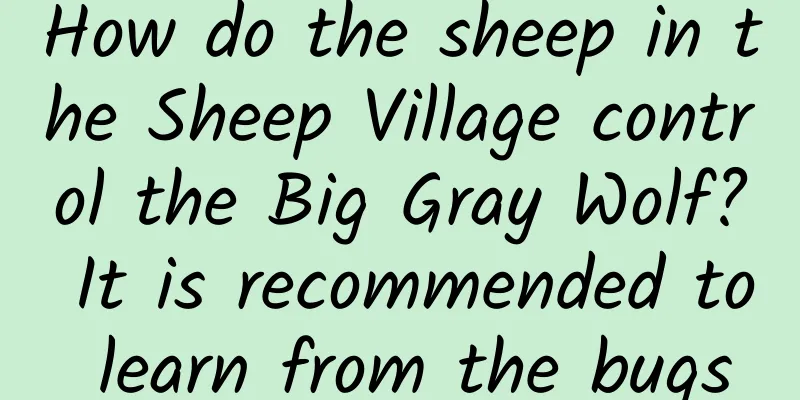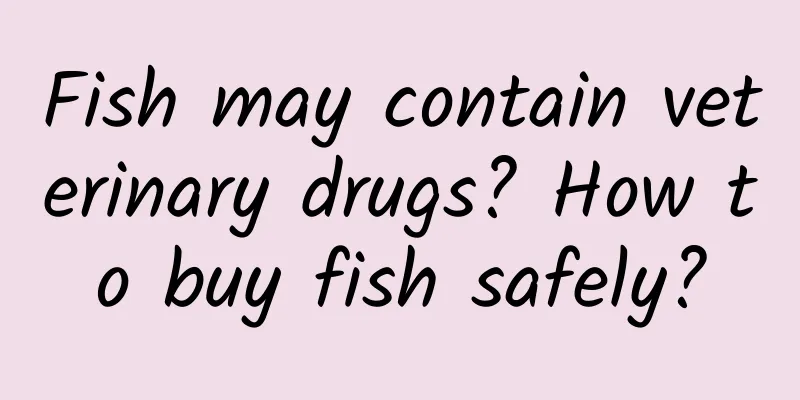How do the sheep in the Sheep Village control the Big Gray Wolf? It is recommended to learn from the bugs

|
Kind tips: This article contains a lot of cute and scary bug pictures, so please use them according to your ability~ When the strong wind blows away the dead leaves on the ground, if you look closely, you will find that some of them are not leaves... It is a good hand at disguising dead leaves. Its name is: ____ Image source: live.staticflickr.com (CC BY-NC 2.0) Another camouflage master - the walnut moth with naked eye 3D special effects Image source: live.staticflickr.com (CC BY-NC-SA 2.0) In order to eat food, or to avoid being eaten as food, organisms have evolved various tricks, the most interesting of which is the phenomenon of mimicry. Mimicry refers to the behavior of one organism imitating another organism. The mimicry angles include but are not limited to appearance, behavior, smell and other aspects. It is often confused with camouflage, which is actually a defensive method used by organisms to blend in with the environment and hide themselves. The insects lying motionless on the fallen leaves at the beginning of the article are two super successful examples of camouflage, and the roles involved in mimicry are more diverse and the mechanisms are more complex. Two classic mimicry: the fox pretending to be the tiger or joining forces Biologists have discovered ingenious mimicry between many organisms. The two most well-known classic types are Batesian mimicry and Müllerian mimicry. The core idea of Batesian mimicry is that the mimic has a weak self-protection ability, and by imitating the mimic with strong self-protection ability (such as poisonous, stinging, smelly and unpalatable, etc.), it can confuse natural enemies and reduce the chance of being preyed on. In Mueller's mimicry, both the mimic and the mimic are species with certain self-protection abilities , and the two enhance the deterrence of predators through the similarity of their defensive characteristics, thus benefiting each other. Taking the characters in the cartoon "Pleasant Goat and Big Big Wolf" as an analogy, we can more intuitively understand the relationship between the characters: on the green grassland there is the lazy Goat who has no ability to fight back, the muscular Boiling Goat, and the Big Big Wolf who thinks about eating mutton every day. Batesian mimicry is like Lazy Sheep pretending to be Boiling Sheep to scare Big Bad Wolf; while Muscular mimicry is like Boiling Sheep and another muscular sheep joining forces to fight Big Bad Wolf. The hoverfly, which looks like a bee but has no sting, is a classic example of Batesian mimicry. Image source: wikimedia.org (CC0 1.0) The poisonous and morphologically similar butterfly is a common research model for Mueller's mimicry. Image source: en.wikipedia.org (CC BY 2.5) Gibbs mimicry: How did a sheep end up in wolf skin? The classic mimicry model mentioned above includes three species , whose roles are mimicry, mimicked and deceived natural enemy . However, in a special mimicry relationship, the distribution of roles is slightly changed: the mimicry remains unchanged, while the mimicked and deceived natural enemy are the same species . This special mimicry is called " Gilbertian Mimicry ", which is named after American ecologist Lawrence Gilbert to commemorate his outstanding contributions in related fields. In the 1970s, Gilbert discovered a peculiar phenomenon while studying the relationship between Heliconius spp. and its host plant, Passiflora spp.: some passion flowers have yellow spots on their leaves that resemble butterfly eggs . These yellow spots visually mislead female Heliconius spp. into thinking that such leaves have been visited by their own kind. Since laying eggs repeatedly on the same leaf will expose Heliconius larvae to too much competition from their own kind, mother Heliconius spp. will try to avoid laying eggs on passion flower leaves with spots. By disguising itself as its natural enemy (when it was young), the passion flower with yellow markings on its leaves managed to escape the disaster. Heliconius charithonia and Passiflora biflora Image source: commons.wikimedia.org (CC BY-SA 2.0 & CC BY-3.0) Still using the wolf and sheep as an example, the situation of Ji's mimicry is like this: Lazy Sheep has no way to escape, so he takes a risk and puts on Big Bad Wolf's clothes. When the real Big Bad Wolf passes by him, he thinks it is a wolf from the next village who comes to visit, and does not realize Lazy Sheep's true identity. In the end, Lazy Sheep, who pretends to be Big Bad Wolf, successfully captures Big Bad Wolf and survives by chance, while the deceived Big Bad Wolf loses his prey - isn't this the reverse version of "wolf in sheep's clothing", becoming "sheep in wolf's clothing"! The yellow spots are not caused by the butterfly, but by the passion flower itself. Image source: commons.wikimedia.org (CC BY-3.0) Not only plants, but animals also use Gibbs mimicry Due to the lack of early research cases, the academic community has a relatively narrow definition of Gibbs mimicry, describing its law as a defensive mimicry behavior of plants. However, subsequent studies have found that Gibbs mimicry exists not only between plants and animals, but also between animals . In the 1980s, several biologists from the United States and Canada published academic articles, all of which focused on the discovery that the wing patterns of Tephritidae insects and predatory Salticidae spiders were quite similar. The two formed a novel mimicry relationship, which set off the second wave of Gibbs mimicry research. Do you think the pattern on this fly's wings resembles a jumping spider? Image source: Reference 4 Subsequently, biologists have also discovered patterns similar to those of jumping spiders in other insects, including Derbidae, Tortricidae, and Psocoptera. The shapes and colors of these patterns vary, and the specific characteristics of the patterns are often related to the local distribution of jumping spider species . For example, the eagle moths and weaver moths in low-latitude areas imitate tropical species as colorful as peacock jumping spiders. Three species of cicadas and the jumping spiders they imitate (bottom right) Image source: Reference 3 The "little moths" with jumping spider-like patterns on their wings Image source: Reference 3 The peacock jumping spider said: "It feels a bit similar" Image source: animalvogue.com (public domain) The development of things often follows the rule that quantitative change leads to qualitative change. When the reported cases of Gibbs mimicry accumulate to a certain number, the research focus will inevitably shift to how to prove its effectiveness. A fruit fly called Zonosemata vittigera provides us with the answer. This fruit fly not only simulates the typical appearance of jumping spiders from a frontal perspective (including large single eyes and well-developed pedipalps) in terms of morphology, but also flutters its wings when encountering real jumping spiders to simulate the courtship behavior of jumping spiders during mating. Under this double deception of the fruit fly, jumping spiders did respond accordingly in experimental tests , such as showing avoidance behavior when encountering their own kind, and courtship behavior when encountering the opposite sex. Another more comprehensive recent study shows that convolutional neural network algorithms can be used to verify the relationship between jumping spiders and many mimics. After evaluating the mimicry group, observation angle, observation distance, etc., the study confirmed that there is a high degree of morphological similarity between jumping spiders and their mimics. Whether it is Batesian mimicry, Mueller's mimicry or Gibbsian mimicry, our understanding of these special phenomena is far from enough. I believe that with further exploration and discovery, there will be more interesting new biological knowledge waiting to be unveiled by humans in the future. References: [1] Carlos E. Muñoz-Amezcua, Horacio Tapia-McClung, Dinesh Rao. (2023) When a glimpse is enough: Partial mimicry of jumping spiders by insects [J]. [2] Gilbert LE. (1975) Ecological consequences of a coevolved mutualism between butterflies and plants [J]. [3] Hill DE, Burini JP. Apc A. (2019) Self portraits by jumping spiders 1 PECKHAMIA 179.1[J]. 2019. [4] Mather, MH, Roitberg, BD. (1987) A sheep in wolf's clothing: tephritid flies mimic spider predators. [5] Whitman DW, Larry O, Erick G. (1988) Spider Mimicry in Fruit Flies (Diptera: Tephritidae): Further Experiments on the Deterrence of Jumping Spiders (Araneae: Salticidae) by Zonosemata vittigera (Coquillett)[J]. Author: Ge Yingqiang This article is from the "Science Academy" public account. Please indicate the source of the public account when reprinting. |
<<: He may have drawn more pictures than you have walked.
>>: Can you "recharge" yourself by getting more sun? Uncover the secret of energy in the sun
Recommend
The first great ape named by the Chinese, fewer than 150 of them are still alive
The Tianxing gibbon was officially named by Chine...
Talking about Programmers Series: Oh, I am a ghost problem!
Programmers (software development engineers) have...
Online Promotion: How to plan a successful event?
How is a complete event planned and implemented? ...
Three Elements of a Truly Intelligent Robot
I finally took some time out yesterday to finish ...
Reference data for 11 categories of second-tier e-commerce on the Qutoutiao platform
Today I’d like to share with you a wave of second...
What was the appearance of the universe like 13.8 billion years ago? The most distant "baby galaxy" tells you the answer →
The existence of JADES-GS-z14-0 is like an "...
How to choose a good mini program development company?
With the continuous advancement of Internet techn...
How to create and attract traffic for “TikTok Startup Account” short videos?
This issue shares an article about how to attract...
Weird open source component: Play the "Brick Breaker" game in the pull-down refresh
That’s right, now you can play Breakout while you...
Besides the fireworks in March and Huaiyang cuisine, what else can truly represent Yangzhou?
Mention Yangzhou Some people think of fresh and p...
National New Energy Vehicle Project Team: Four points to understand the energy consumption of electric vehicles per 100 kilometers is the key to getting points
Statistics show that China consumed 556 million t...
What can Uber learn from Airbnb in international expansion?
As Silicon Valley's hottest startups with a v...
Exclusive interview with Ronglian Cloud Communications CTO Xu Zhiqiang: APP quickly realizes technical communication capabilities
[[127128]] In the past 2014, 4G and mobile APPs h...
How to promote Xiaohongshu notes to become popular?
It is indeed difficult for a new account to becom...
Learning Numerical Algorithms with Playground
In middle school, there was nothing more terrifyi...









